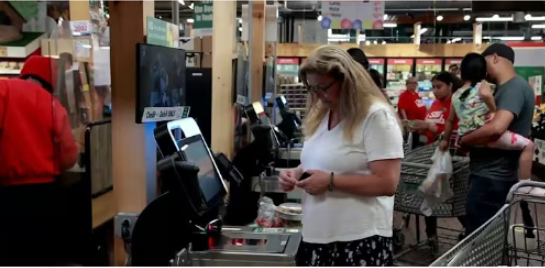Get ready to be surprised—these everyday stores are quietly going all-in on self-checkouts
- Replies 0
Self-checkout machines have become a familiar sight at grocery stores and big-box retailers.
But now, they’re showing up somewhere you might not expect—your neighborhood convenience store.
The next time you stop for snacks or gas, don’t be surprised if you’re scanning your own items instead of chatting with a cashier.
The rise of self-service tech isn’t slowing down. In February, two regional convenience chains—Wesco and Parker’s Kitchen—announced the rollout of self-checkout kiosks.
They're joining more than 3,000 convenience stores nationwide that already use the technology.
The main selling point? Speed. Executives say customers want faster ways to get in and out—and for now, staff are still present to assist.
Both companies confirmed that no jobs have been cut due to the shift.
Americans are warming up to self-checkout.
A recent Capital One Shopping survey found that nearly 96% of shoppers have used it at least once.
More than 7 in 10 said they actually prefer it at grocery stores over traditional checkout lines.
Still, not everyone is convinced that self-checkout fits well in smaller retail spaces.
Read more: Why shoppers are turning away from Walmart’s self-checkout—what’s going on?
Fidaa Mohrez, Senior Director of Operational Systems at a West Coast convenience store group, said their team decided to pause any expansion plans.
“Operating with one employee often means they can’t both serve customers and monitor self-checkout,” he explained.
Retailers spent nearly $24 billion upgrading self-checkout systems in 2023 alone.
That number is expected to soar past $48 billion by 2033.
But for all the investment, the response hasn’t been all positive.
Big names like Target and Walmart rolled out self-checkouts across the country—only to walk some of it back.
Complaints from customers and a spike in theft forced them to reintroduce staffed registers.
Industry experts warn that unless self-checkouts are as easy—or easier—than traditional lanes, the tech might end up frustrating more shoppers than it helps.
Also read: Shoppers outraged: ALDI's latest policy has self-checkouts collecting dust—find out why it's causing such a stir
The self-checkout wave is also catching the eye of state legislators.
California, Washington, and Connecticut have introduced bills aimed at slowing or limiting kiosk use.
Concerns include potential job losses, increased pressure on law enforcement, and accessibility issues for customers who may not be tech-savvy.
Read next: Sam's Club says goodbye to self-checkout—what it means for your next shopping trip

Are you team self-checkout, or do you miss speaking with a cashier? Have you had any great—or not-so-great—experiences with self-service kiosks? Share your thoughts in the comments below.
But now, they’re showing up somewhere you might not expect—your neighborhood convenience store.
The next time you stop for snacks or gas, don’t be surprised if you’re scanning your own items instead of chatting with a cashier.
The rise of self-service tech isn’t slowing down. In February, two regional convenience chains—Wesco and Parker’s Kitchen—announced the rollout of self-checkout kiosks.
They're joining more than 3,000 convenience stores nationwide that already use the technology.
The main selling point? Speed. Executives say customers want faster ways to get in and out—and for now, staff are still present to assist.
Both companies confirmed that no jobs have been cut due to the shift.
Americans are warming up to self-checkout.
A recent Capital One Shopping survey found that nearly 96% of shoppers have used it at least once.
More than 7 in 10 said they actually prefer it at grocery stores over traditional checkout lines.
Still, not everyone is convinced that self-checkout fits well in smaller retail spaces.
Read more: Why shoppers are turning away from Walmart’s self-checkout—what’s going on?
Fidaa Mohrez, Senior Director of Operational Systems at a West Coast convenience store group, said their team decided to pause any expansion plans.
“Operating with one employee often means they can’t both serve customers and monitor self-checkout,” he explained.
Retailers spent nearly $24 billion upgrading self-checkout systems in 2023 alone.
That number is expected to soar past $48 billion by 2033.
But for all the investment, the response hasn’t been all positive.
Big names like Target and Walmart rolled out self-checkouts across the country—only to walk some of it back.
Complaints from customers and a spike in theft forced them to reintroduce staffed registers.
Industry experts warn that unless self-checkouts are as easy—or easier—than traditional lanes, the tech might end up frustrating more shoppers than it helps.
Also read: Shoppers outraged: ALDI's latest policy has self-checkouts collecting dust—find out why it's causing such a stir
The self-checkout wave is also catching the eye of state legislators.
California, Washington, and Connecticut have introduced bills aimed at slowing or limiting kiosk use.
Concerns include potential job losses, increased pressure on law enforcement, and accessibility issues for customers who may not be tech-savvy.
Read next: Sam's Club says goodbye to self-checkout—what it means for your next shopping trip
Key Takeaways
- Self-checkouts are expanding into convenience stores, with over 3,000 locations now offering the option.
- Chains like Wesco and Parker’s Kitchen say the goal is faster service, and they’ve kept staff on-site to assist.
- Surveys show nearly 96% of Americans have used self-checkout, but concerns remain about customer experience and potential job cuts.
- Some states have introduced legislation to limit the spread of self-checkout tech due to theft concerns, accessibility issues, and workforce impact.
Last edited:







